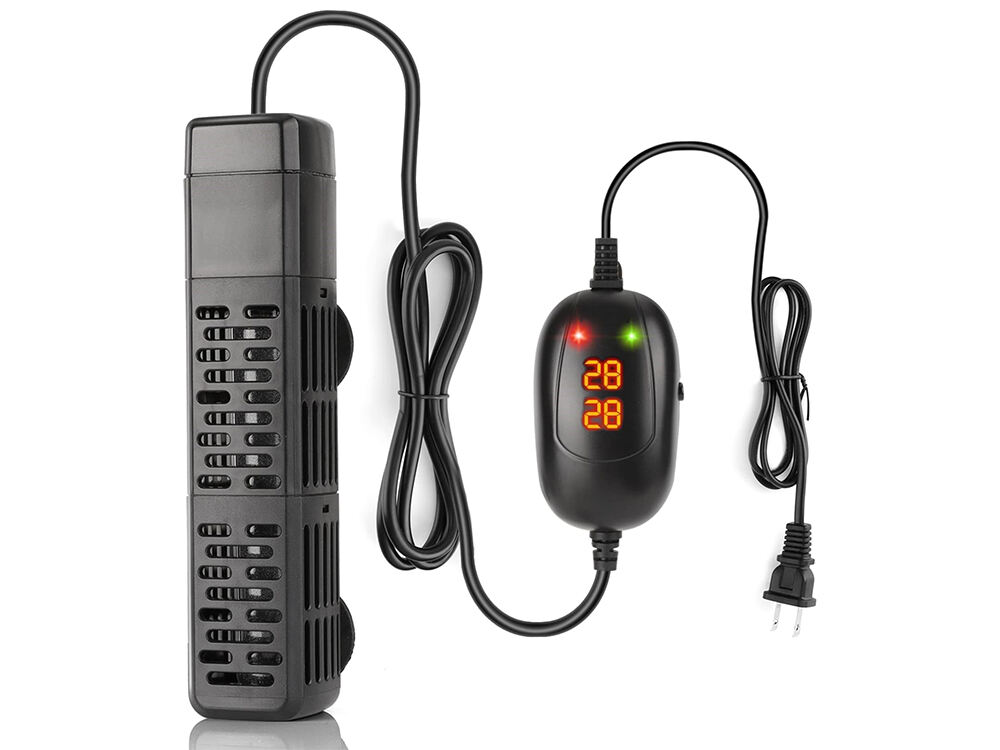Κατανόηση της στιγμής και του λόγου που χρειάζεστε την καλύτερη θερμάστρα ενυδρείου
Χρειάζεται το ενυδρείο μου θερμάστρα;
Οι περισσότεροι τροπικοί ψαρικοί αντιμετωπίζουν πραγματικά δυσκολίες όταν η θερμοκρασία του νερού ανεβοκατεβαίνει πολύ, γι' αυτό η αγορά ενός καλού θερμαντικού στοιχείου είναι σχεδόν απαραίτητη, εκτός κι αν ζείτε κάπου όπου η θερμοκρασία παραμένει φυσικά περίπου 75 έως 80 βαθμούς όλο το χρόνο. Τα χρυσόψαρα και άλλα είδη ψυχρού νερού μπορούν να αντέξουν λίγο χαμηλότερες θερμοκρασίες, ίσως στην περιοχή των 60 έως 70 βαθμών, αλλά ακόμη κι αυτά μπορεί να υποστούν στρες αν συμβεί ξαφνική μεγάλη πτώση της θερμοκρασίας. Όποιος παρατηρεί ότι το σπίτι του γίνεται κρύο τις χειμωνιάτικες νύχτες ή ζεστό τις καλοκαιρινές απογευματινές ώρες, θα έπρεπε σίγουρα να εξετάσει την εγκατάσταση ενός θερμαντικού στοιχείου ενυδρείου. Αυτές οι μικρές συσκευές βοηθούν να διατηρηθεί η σταθερότητα και να αποφευχθούν οι διακυμάνσεις θερμοκρασίας που προκαλούν στρες και μπορούν να αρρωστήσουν τα ψάρια ή ακόμη χειρότερα.
Ιδανική Θερμοκρασία Ενυδρείου για Τροπικά έναντι Ψυχρού Νερού Ψάρια
Τα τροπικά ψάρια ευδοκιμούν στους 24–27°C, αντανακλώντας τα γλυκά νερά των ισημερινών περιοχών, ενώ τα ψύχραιμα είδη προτιμούν τους 15–21°C. Σύμφωνα με τον Οδηγό Υδρόβιων Περιβαλλόντων 2024, η παρατεταμένη έκθεση σε θερμοκρασίες εκτός αυτών των ορίων εξασθενεί το ανοσοποιητικό σύστημα και αυξάνει την επιρρέψιμοτητα σε ασθένειες. Για ενυδρεία με πολλά είδη, προτεραιοποιήστε τις ανάγκες των ευαίσθητων ως προς τη θερμοκρασία οργανισμών, όπως οι ψαροκυρίες ή τα τέτρα.
Πώς Η Θερμοκρασία Του Δωματίου Επηρεάζει Τις Ανάγκες Θέρμανσης
Όταν διατηρείτε ένα ενυδρείο στους 78 βαθμούς Φαρενάιτ, πραγματικά χρειάζεται περίπου 33 τοις εκατό περισσότερη ενέργεια αν η περιβάλλουσα αίθουσα είναι μόνο 72 βαθμοί αντί για 75. Το θερμαντικό σώμα πρέπει να λειτουργεί πολύ σκληρότερα όταν υπάρχει μεγαλύτερη διαφορά μεταξύ της θερμοκρασίας έξω από το ενυδρείο και αυτής που επιθυμούμε μέσα. Αυτό επιδεινώνεται ακόμα περισσότερο σε χώρους όπου υπάρχουν αεράκια ή σε ψυχρούς υπόγειους χώρους. Σύμφωνα με έρευνες σχετικά με υδάτινα περιβάλλοντα, οι ειδικοί προτείνουν να παρακολουθείτε πώς μεταβάλλεται η θερμοκρασία του δωματίου κατά τη διάρκεια της ημέρας. Η ελέγχου κάθε μίας ώρας περίπου βοηθά στο να αποτρέψει την υπερβολική καταπόνηση του θερμαντικού σώματος, καθώς προσπαθεί να ανταποκριθεί σε αιφνίδιες πτώσεις της θερμοκρασίας.
Επιλογή της Κατάλληλης Ισχύος Βάσει του Μεγέθους του Ενυδρείου
Ποιο Μέγεθος Θερμαντικού Σώματος Ενυδρείου Χρειάζομαι;
Η επιλογή της κατάλληλης ισχύος αποτρέπει τη σπατάλη ενέργειας και εξασφαλίζει σταθερές θερμοκρασίες. Ο βασικός κανόνας των 3-5 βατ ανά γαλόνι ισορροπεί την απόδοση με τη θερμαντική ισχύ, αν και η θερμοκρασία του δωματίου και η μόνωση του ενυδρείου επηρεάζουν σημαντικά τις πραγματικές ανάγκες.
Οδηγίες Ισχύος: Εξήγηση του Κανόνα 3-5 Watt ανά Γαλόνι
Αυτή η οδηγία υποθέτει αύξηση θερμοκρασίας κατά 10°F πάνω από την περιβάλλουσα. Για ψυχρότερα δωμάτια ή βυθούς χρειάζονται ακριβής επάρκεια θερμότητας, προτιμήστε τα 5 watt/γαλόνι. Μια δεξαμενή 20 γαλονιών σε δωμάτιο 68°F που χρειάζεται 78°F τροπικές θερμοκρασίες θα απαιτούσε 100W (5W x 20 γαλόνια).
Προτεινόμενη Ισχύς Θερμαντήρα για Συνηθισμένα Μεγέθη Δεξαμενών (10 έως 100+ Γαλόνια)
| Διαστάσεις δεξαμενής | Ελάχιστη Ισχύς (3W/γαλ) | Βέλτιστη Ισχύς (5W/γαλ) | Λύση για Μεγάλη Διακύμανση Θερμοκρασίας |
|---|---|---|---|
| 10 Γαλ | 30W | 50W | 75W |
| 40 γαλόνια | 120W | 200W | 2x100W θερμαντήρες |
| 75 γαλ | 225W | 375w | 2x200W θερμαντήρες |
Χρήση Πολλαπλών Θερμαντήρων για Καλύτερη Κατανομή Θερμότητας σε Μεγάλες Δεξαμενές
Τα μπουκάλια άνω των 40 γαλονιών επωφελούνται από διπλούς θερμαντήρες που τοποθετούνται σε αντίθετα άκρα. Αυτή η διάταξη παρέχει πλεονασμό και εξαλείφει τις ψυχρές ζώνες. Για ένα μπουκάλι 100 γαλονιών, δύο θερμαντήρες των 250W προσφέρουν ασφαλέστερη και πιο σταθερή θέρμανση από έναν μόνο θερμαντήρα 500W—κάτι ιδιαίτερα σημαντικό όταν επιλέγετε τον καλύτερο θερμαντήρα ενυδρείου για ευαίσθητα είδη.
Βασικά Χαρακτηριστικά Ενός Αξιόπιστου και Ασφαλούς Θερμαντήρα Ενυδρείου
Ρυθμιζόμενα Θερμοστάτη και Ακρίβεια Θερμοκρασίας
Οι καλοί θερμαντήρες ενυδρείου πρέπει να διατηρούν τη θερμοκρασία εντός μισού βαθμού Φαρενάιτ, κάτι που έχει μεγάλη σημασία όταν εκτρέφετε ευαίσθητα ψάρια όπως οι δίσκοι ή όταν διατηρείτε ενυδρεία με κοράλλια. Κατά την αγορά, επιλέξτε συσκευές με ψηφιακούς θερμοστάτες που επιτρέπουν στους χρήστες να ρυθμίζουν τις τιμές σε επιμέρους βαθμούς, αντί για τους παλιομοδίτικους αναλογικούς διακόπτες που συχνά χάνουν την ακρίβειά τους με την πάροδο του χρόνου. Σύμφωνα με έρευνα που δημοσιεύθηκε από το Ινστιτούτο Ασφάλειας Εξοπλισμού Υδάτινων Οικοσυστημάτων πέρυσι, οι ενυδρειοφίλοι που αναβάθμισαν σε αυτούς τους ακριβείς θερμαντήρες είδαν μια δραματική μείωση στις απώλειες λόγω ταλαντώσεων θερμοκρασίας — περίπου δύο τρίτα λιγότερα νεκρά ψάρια σε σύγκριση με όσους χρησιμοποιούσαν βασικά μοντέλα χωρίς τέτοιες λεπτές ρυθμίσεις.
Απαραίτητα Χαρακτηριστικά Ασφαλείας: Αυτόματη Απενεργοποίηση, Προστασία από Υπερθέρμανση, Ανθεκτικότητα σε Θραύση
Προτεραιοποιήστε θερμαντικά σώματα με τριπλή αντιστάθμιση: αυτόματο διακόπτη ισχύος κατά τη διάρκεια βλαβών, θερμικές ασφάλειες για προστασία από υπερθέρμανση και ανθεκτικά υλικά που δεν σπάνε, όπως τιτάνιο ή ενισχυμένο γυαλί. Τα βυθιζόμενα μοντέλα πρέπει να πληρούν τα πρότυπα στεγανότητας IP68, κάτι κρίσιμο για εγκαταστάσεις με θαλασσινό νερό όπου η διάβρωση επιταχύνει την αποτυχία του εξοπλισμού.
Αξιόπιστες Μάρκες και Αποφυγή Θερμαντικών Σωμάτων Χαμηλής Ποιότητας ή Χρησιμοποιημένων
Ενώ τα οικονομικά θερμαντικά σώματα μπορεί να κοστίζουν αρχικά 40% λιγότερο, στοιχεία από τον κλάδο για τους ρυθμούς βλάβης δείχνουν ότι χρειάζονται αντικατάσταση 2,3 φορές πιο γρήγορα από τα προηγμένα μοντέλα. Αποφύγετε εντελώς τα χρησιμοποιημένα θερμαντικά σώματα — διαβρωμένα εσωτερικά εξαρτήματα πολύ συχνά παρακάμπτουν τα πρωτόκολλα ασφαλείας. Οι αξιόπιστοι κατασκευαστές υποβάλλουν τα προϊόντα τους σε δοκιμές καταπόνησης πάνω από 10.000 ώρες, συμπεριλαμβανομένων προσομοιώσεων λειτουργίας χωρίς νερό και αντοχής σε αιφνίδιες αυξήσεις τάσης.
Ενεργειακή Απόδοση και Μακροχρόνια Αξιοπιστία
Οι σημερινοί θερμαντήρες με inverter καταναλώνουν στην πραγματικότητα περίπου 15 έως ίσως και 20 τοις εκατό λιγότερη ηλεκτρική ενέργεια σε σύγκριση με τα παλιομοδίτικα μοντέλα αντίστασης, διατηρώντας παράλληλα τις θερμοκρασίες πολύ πιο σταθερές. Όταν ψωνίζετε, αναζητήστε μοντέλα που διαθέτουν θερμαντικά στοιχεία τιτανίου αντί για γυάλινα. Η εμπειρία δείχνει ότι αυτά τα στοιχεία τιτανίου τείνουν να παραμένουν αποδοτικά περίπου 35% περισσότερο όταν χρησιμοποιούνται σε νερό με πολλά μέταλλα διαλυμένα σε αυτό. Τα μεγαλύτερα συστήματα με δεξαμενές άνω των 75 γαλονιών επωφελούνται πραγματικά από την εγκατάσταση δύο θερμαντήρων 150 watt μαζί. Αυτή η ρύθμιση όχι μόνο αποτρέπει προβλήματα σε περίπτωση βλάβης ενός θερμαντήρα, αλλά εξοικονομεί και χρήματα από τους λογαριασμούς ηλεκτρικού ρεύματος καθ' όλη τη διάρκεια του έτους. Η Εθνική Ένωση Ενυδρείων έκανε κάποια έρευνα το 2023 και διαπίστωσε ότι αυτός ο συνδυασμός συνήθως μειώνει τα ετήσια έξοδα κάπου μεταξύ είκοσι δύο και τριάντα δολαρίων.
Σωστή Εγκατάσταση, Τοποθέτηση και Συντήρηση του Καλύτερου Θερμαντήρα Ενυδρείου
Καλύτερη τοποθέτηση για ομοιόμορφη κατανομή της θερμότητας (κοντά στην έξοδο του φίλτρου ή σε περιοχή με ροή νερού)
Τοποθετήστε το θερμαντήρα του ενυδρείου είτε οριζόντια είτε σε γωνία κοντά στο σημείο όπου το νερό κινείται πολύ, όπως ακριβώς δίπλα στην έξοδο του φίλτρου. Τοποθετώντας το εκεί βοηθά να σταματήσει αυτά τα ενοχλητικά κρύα σημεία που σχηματίζονται όταν μέρη της δεξαμενής γίνονται πολύ κρύα επειδή το νερό δεν κυκλοφορεί σωστά. Επίσης, κρατήστε το θερμαντήρα μακριά από τις πλευρές της δεξαμενής και από οποιεσδήποτε διακοσμήσεις βρίσκονται στο κάτω μέρος. Οι μικρές ταραχές και τα χτυπήματα από τα εργαλεία που λειτουργούν μπορεί τελικά να σπάσουν τα γυάλινα μοντέλα, οπότε το να τους δώσουμε λίγο χώρο έχει νόημα για μακροπρόθεσμη αξιοπιστία.
Οδηγός εγκατάστασης βήμα προς βήμα για τα θερμαντήρες βυθόπλυσης και ενδοστρόφιας θέρμανσης
- Υδροβυθούμενες μονάδες : Βυθίστε πλήρως το θερμαντήρα (με βάση τους ελάχιστους δείκτες στάθμης νερού) και στερέψτε το στο τοίχωμα της δεξαμενής χρησιμοποιώντας αναρριχητικά. Τοποθετήστε το φρένο μόνο μετά από 20-30 λεπτά προσαρμογής στο νερό για να αποφευχθεί το θερμικό σοκ.
- Προγράμματα σε γραμμή : Συνδέεται με τον εξωτερικό σωλήνα φίλτρου του δοχείου χρησιμοποιώντας εξαρτήματα που παρέχονται από τον κατασκευαστή. Οι δοκιμές δείχνουν ότι τα συστήματα ενδοδιαστολής θερμαίνονται 15%~20% ταχύτερα, διατηρώντας παράλληλα την κρυφή αισθητική.
Πρέπει να αφήνετε πάντα ανοιχτό το θερμοσίφωνα του ενυδρείου;
Οι περισσότεροι σύγχρονοι θερμαντήρες με θερμοστάτη είναι σχεδιασμένοι για συνεχή λειτουργία, με αποτέλεσμα να απενεργοποιούνται οι κίνδυνοι πτώσης της θερμοκρασίας κατά τη διάρκεια της νύχτας ή των κρύων στιγμών. Εξαιρέσεις ισχύουν κατά τη διάρκεια αλλαγών νερού: αποσυνδέστε τα θερμαντικά όταν το επίπεδο νερού πέσει κάτω από τα ελάχιστα σημεία για την αποφυγή ζημιών από υπερθέρμανση.
Συνήθως παρουσιάζονται προβλήματα ρουτίνας και αντιμετώπισης προβλημάτων
| Έργο | Συχνότητα | Εργαλεία που χρειάζονται |
|---|---|---|
| Καθορισμός θερμοστάτη | Ετήσια | Ατομικό ψηφιακό θερμόμετρο |
| Καθαρισμός Επιφανειών | Κάθε δύο εβδομάδες | Μαλακή οδοντόβουρτσα |
| Πλήρης έλεγχος | Κάθε χρόνο | Κανένας (αν έχει σπάσει, αντικαταστήστε) |
Οι διαρκείς διακυμάνσεις της θερμοκρασίας συχνά σηματοδοτούν την συσσώρευση μεταλλικών στοιχείων στα θέρμαντα στοιχεία. Για τα μοντέλα τιτανίου, βουτήξτε το σε λευκό ξύδι (ανάλογα με την αναλογία 1:3 με νερό) για 30 λεπτά πριν από το απαλό τρίψιμο.
Συχνές ερωτήσεις
Γιατί είναι απαραίτητο ένα θερμαντήρα ενυδρείου;
Ένα θερμαντήρα ενυδρείου βοηθά στη διατήρηση σταθερής θερμοκρασίας κατάλληλης για τα ψάρια, αποτρέποντας ξαφνικές πτώσεις ή αυξήσεις που μπορούν να προκαλέσουν άγχος ή να βλάψουν τα ψάρια.
Τι μέγεθος θερμαντήρα είναι κατάλληλο για την δεξαμενή μου;
Ακολουθήστε τον κανόνα 3-5 βατ ανά γαλόνι. Λάβετε υπόψη σας τις μεταβολές της θερμοκρασίας του δωματίου και τις συγκεκριμένες ανάγκες των κατοίκων της δεξαμενής σας.
Πώς πρέπει να τοποθετήσω τη συσκευή θέρμανσης του ενυδρείου;
Τοποθετήστε την κοντά σε περιοχές ροής νερού για ομοιόμορφη κατανομή της θερμότητας, αποφεύγοντας την επαφή με τα πλάγια της δεξαμενής ή με διακοσμητικά αντικείμενα.
Μπορεί η συσκευή θέρμανσης να παραμένει συνεχώς ενεργοποιημένη;
Ναι, οι σύγχρονες συσκευές θέρμανσης με θερμοστάτη προορίζονται για συνεχή λειτουργία. Εξαιρέσεις παρουσιάζονται κατά τη διάρκεια συντήρησης, όπως η αλλαγή νερού.
Πίνακας Περιεχομένων
- Κατανόηση της στιγμής και του λόγου που χρειάζεστε την καλύτερη θερμάστρα ενυδρείου
- Επιλογή της Κατάλληλης Ισχύος Βάσει του Μεγέθους του Ενυδρείου
- Βασικά Χαρακτηριστικά Ενός Αξιόπιστου και Ασφαλούς Θερμαντήρα Ενυδρείου
-
Σωστή Εγκατάσταση, Τοποθέτηση και Συντήρηση του Καλύτερου Θερμαντήρα Ενυδρείου
- Καλύτερη τοποθέτηση για ομοιόμορφη κατανομή της θερμότητας (κοντά στην έξοδο του φίλτρου ή σε περιοχή με ροή νερού)
- Οδηγός εγκατάστασης βήμα προς βήμα για τα θερμαντήρες βυθόπλυσης και ενδοστρόφιας θέρμανσης
- Πρέπει να αφήνετε πάντα ανοιχτό το θερμοσίφωνα του ενυδρείου;
- Συνήθως παρουσιάζονται προβλήματα ρουτίνας και αντιμετώπισης προβλημάτων
- Συχνές ερωτήσεις










